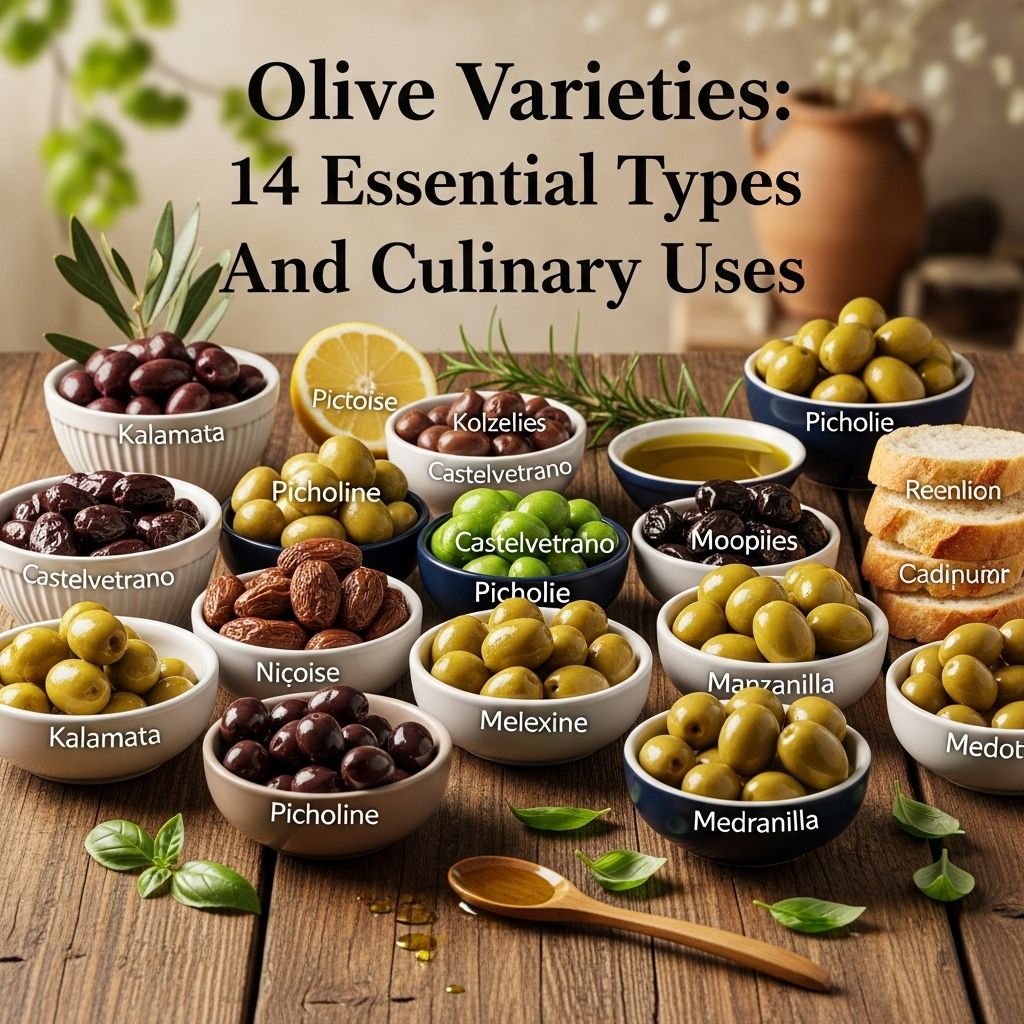A Comprehensive Guide to Olive Varieties: Flavors, Uses, and Origins
Discover unique tastes and regional heritage that elevate every dish to new heights.

A Comprehensive Guide to Olive Varieties
Olives are more than a staple of the Mediterranean—they are a world of flavors, textures, and culinary applications waiting to be explored. With hundreds of varieties grown across different continents, olives come in a spectrum of flavors from crisp and grassy to meaty and briny. This comprehensive guide highlights 14 beloved olive types, shedding light on their origins, curing methods, flavor profiles, and the most delicious ways to enjoy them.
Table of Contents
- Why Olive Varieties Matter
- The Art and Science of Olive Curing
- Guide to 14 Essential Olive Varieties
- Frequently Asked Questions
Why Olive Varieties Matter
Olives are a type of stone fruit—just like cherries and peaches. But unlike most fruits, olives are incredibly bitter when freshly picked and are almost always cured or fermented before eating. The variety of olive you choose has a major impact on the dish, affecting:
- Flavor: Ranges from grassy and tart to buttery and nutty.
- Texture: Some are firm and crisp; others tender and meaty.
- Color: Not just green or black—purple, brown, and almost gold.
- Best Uses: Snack, garnish, salad ingredient, or tapenade base.
The tremendous diversity in olive characteristics comes from both their genetic variety and regional curing traditions.
The Art and Science of Olive Curing
Fresh olives are inedibly bitter, so they must be cured before eating. The method of curing shapes the flavor, aroma, and texture:
- Brine curing: Soaking in saltwater. Slow and traditional, yields nuanced flavors and gentle textures.
- Dry curing: Packed in salt, then often stored in oil. Results in ultra-concentrated, wrinkled, intensely flavored olives.
- Lye curing: A chemical shortcut that speeds up the debittering process. Typically yields a milder flavor and tender flesh.
- Water curing: Simpler method, common for home-curing, involves repeated rinsing in water to leach bitterness.
Alongside curing, additional flavorings—herbs, citrus, garlic, or chili—might be added for extra complexity.
Guide to 14 Essential Olive Varieties
Below you’ll find a detailed look at 14 of the most celebrated olives, distinguished by country of origin, flavor, and culinary uses.
Manzanilla
- Origin: Spain (especially Andalusia)
- Curing: Brine-cured
- Appearance: Medium to large, green, oval-shaped, small pit
- Flavor profile: Slightly smoky, briny, and rich with a crisp bite
- Best uses: Classic for cocktails (especially stuffed with pimento, garlic, or almond), tapas, salads, and as a general snacking olive
Castelvetrano
- Origin: Sicily, Italy (Valle del Belice)
- Curing: Lightly brined, sometimes lye-cured for signature softness
- Appearance: Vibrant green, plump and round
- Flavor profile: Buttery, mild, sweet, with just a hint of bitterness
- Best uses: Cheese platters, antipasti, salads, pizzas, or simply as a snack for olive newcomers
Picholine
- Origin: France
- Curing: Brine-cured, often with citric acid for color
- Appearance: Slender and green, small to medium
- Flavor profile: Salty, fruity, crisp, and assertive
- Best uses: Cocktails, antipasto platters, with seafood, or tossed into salads
Kalamata
- Origin: Greece
- Curing: Brine-cured, often preserved in red wine vinegar or olive oil
- Appearance: Almond-shaped, deep purple to black
- Flavor profile: Meaty, tangy, fruity, with a smoky undertone
- Best uses: Greek salads, breads, tapenade, pasta, pizza, and snacking
Niçoise
- Origin: France (Nice and Provence)
- Curing: Traditionally brined, sometimes dry-cured
- Appearance: Small, brown-black, often wrinkled
- Flavor profile: Mildly bitter, herbal, with notes of nuts and rich earth
- Best uses: Essential in Salade Niçoise, classic with tuna, capers, and eggs, terrific in tapenade
Gaeta
- Origin: Italy (Lazio region)
- Curing: Oil- or salt-cured; can be smooth or wrinkled
- Appearance: Small, purplish-brown, glossy or wrinkled skin
- Flavor profile: Sweetish, mildly tart, tender, and fruity
- Best uses: Pasta, pizzas, tossed in salads, or as a table olive
Cerignola
- Origin: Italy (Puglia region)
- Curing: Brine-cured
- Appearance: Extra-large, plump; comes in green, black, or even red-dyed varieties
- Flavor profile: Mild, crisp, sweet rather than tangy, very meaty
- Best uses: Eat solo as a snack, add to cheese boards, or serve at parties
Taggiasca / Ligurian
- Origin: Liguria, Italy
- Curing: Brined, often with herbs like rosemary or thyme
- Appearance: Small, purple to brown, slightly wrinkled
- Flavor profile: Nutty, fruity, mild, and smooth textured
- Best uses: Toss on pasta, focaccia, seafood, or salads
Moroccan (Dry-Cured)
- Origin: Morocco
- Curing: Dry-cured in salt then packed in oil
- Appearance: Small, black, wrinkled
- Flavor profile: Intense, concentrated, salty, almost fermented
- Best uses: Tossed in salads, tagines, or eaten with bold cheeses; better for enthusiasts than skeptics
Amphissa
- Origin: Central Greece (Amfissa region, near Delphi)
- Curing: Brined
- Appearance: Plump, green to rosy-violet, smooth
- Flavor profile: Fruity, succulent, balanced saltiness
- Best uses: Greek meze plates, cheese boards, or as a cocktail garnish
Halkidiki
- Origin: Greece (Chalkidiki region)
- Curing: Brined
- Appearance: Large, pale green, almond-shaped
- Flavor profile: Crisp, slightly tart, with a hint of sweetness
- Best uses: Often found stuffed—garlic, cheese, or pimento; excellent for martinis or salads
Arbequina
- Origin: Spain (Catalonia)
- Curing: Brine, sometimes with added smoke or herbs
- Appearance: Small, oval, brownish green to dark brown
- Flavor profile: Mild, buttery, lightly nutty, and very aromatic
- Best uses: Common in olive oil but delightful as a snack, in tapenade, or as a pizza topping
Lucques
- Origin: France (Languedoc)
- Curing: Brined
- Appearance: Bright green, crescent-shaped, plump
- Flavor profile: Smooth, buttery, sweet, with almost no bitterness
- Best uses: The ideal snack olive, pairs beautifully with white wines and mild cheeses
Mission
- Origin: United States (California)
- Curing: Usually lye or brine-cured; often found canned
- Appearance: Medium, oval, black or green depending on ripeness
- Flavor profile: Mild, nutty, subtly sweet with a firm bite
- Best uses: Classic for pizzas, salads, or relished straight from the tin on American tables
Olive Varieties at a Glance
| Olive Variety | Origin | Color | Main Curing Method | Notable Flavors/Uses |
|---|---|---|---|---|
| Manzanilla | Spain | Green | Brine | Stuffed, tapas, cocktails |
| Castelvetrano | Italy | Green | Brine/Lye | Snacking, antipasti |
| Kalamata | Greece | Purple/Black | Brine | Salads, tapenade |
| Picholine | France | Green | Brine | Cocktails, seafood |
| Niçoise | France | Black/Brown | Brine/Dry | Salade Niçoise |
| Gaeta | Italy | Purple/Brown | Salt/Oil | Pasta, pizza |
| Cerignola | Italy | Green/Black | Brine | Snacking, cheese boards |
| Taggiasca/Ligurian | Italy | Purple/Brown | Brine | Pasta, focaccia |
| Moroccan | Morocco | Black | Dry/Oil | Salads, tagines |
| Amphissa | Greece | Green/Violet | Brine | Meze, garnish |
| Halkidiki | Greece | Light Green | Brine | Stuffed, martinis |
| Arbequina | Spain | Brown/Green | Brine | Olive oil, snacks |
| Lucques | France | Green | Brine | Snacks, wine pairings |
| Mission | U.S. (California) | Black/Green | Lye/Brine | Pizzas, salads |
How to Choose and Store Olives
- For the mildest flavor, select Castelvetrano or Lucques olives.
- For classic Mediterranean recipes, reach for Kalamata, Niçoise, or Amphissa.
- If you crave intensity, try the Moroccan dry-cured or Gaeta varieties.
- Keep olives refrigerated once opened and store in their brine for longest freshness.
- Buy from reputable sources: Many fresh-market olives are far superior to canned in taste and texture.
Olives in Cooking: Inspiration & Ideas
- Tapenade: Blend cured olives (especially Niçoise or Kalamata), capers, garlic, and olive oil for a spreadable delight.
- Pasta: Add Gaeta, Taggiasca, or Picholine to pasta sauce for briny complexity.
- Salads: Classic Greek salad comes alive with meaty Kalamatas or crunchy Halkidiki.
- Appetizers: Serve Castelvetrano and Cerignola with cheese, nuts, and cured meats.
- Baked dishes: Olives make focaccia, savory tarts, or stews more robust and aromatic.
Frequently Asked Questions (FAQs)
Q: What’s the difference between green and black olives?
A: The distinction is often ripeness: Green olives are harvested young, while black olives are ripe. The same variety can sometimes be either green or black, depending on when picked and curing methods.
Q: What makes olives taste bitter when raw?
A: Raw olives contain bitter compounds (notably oleuropein) that make them inedible until removed through curing or fermenting.
Q: Are olives healthy?
A: Yes, olives are high in unsaturated fats, vitamin E, antioxidants, and are a core part of the Mediterranean diet. Enjoy in moderation due to sodium content, especially for brined varieties.
Q: What’s the best olive for beginners?
A: Castelvetrano olives from Sicily are renowned for their buttery, mild, and sweet flavor—an ideal starting point for those new to olives.
Q: Can you grow olives at home?
A: Olive trees require a subtropical or warm temperate climate. While possible in parts of California and the Mediterranean, they are challenging in colder regions.
Explore, Taste, and Enjoy!
With so many varieties, olive lovers and skeptics alike can find a type to love. Whether snacked upon, served in a martini, or crowned atop a salad, olives offer a journey through centuries of culture and flavor—one bite at a time.
References
Read full bio of Srija Burman












